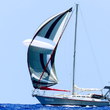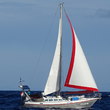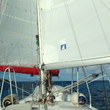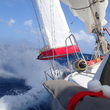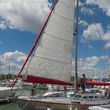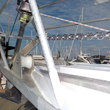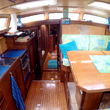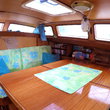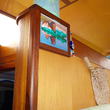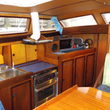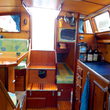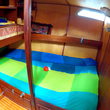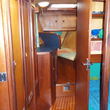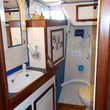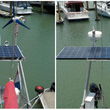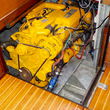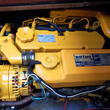Sold!
Because of a change of plans we are going to sell Omweg. This unique robust off shore boat has so many special features that it is impossible to describe them all in a few words.
The design of the boat is unique. One remarkable feature is the Trecker head sail, which resembles a second main sail. Balanced, self-tacking, fully battened, it is easy to operate yet gives total control over the shape and trim of the sail. Another rare feature for a boat this size is the tiller steering, providing a lot of feel, cockpit space and reliability. Asymmetric twin keels allow for a shallow draft, the option to park the boat on a beach, while providing stable sail characteristics. The interior is built around a Deck Salon, allowing an unhindered view outside while sitting and providing an unusual amount of storage space.
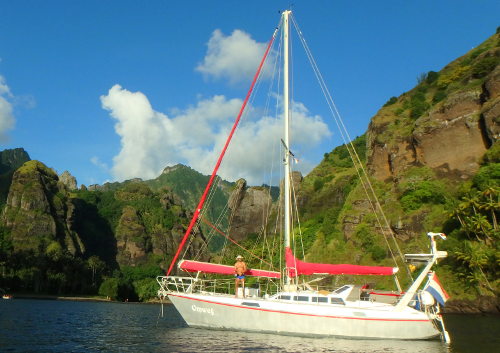
Omweg is built and maintained to last. The hull is very robust with 6mm marine grade alloy for the sides and 8mm for the bottom. The first owner was a German engineer who built the Deck Salon interior with the best possible materials and great feel for detail. The second and current owners have replaced, upgraded and overhauled practically everything in 2015 before sailing her from Europe to New Zealand. The best possible materials have been used everywhere. Like for example a special unstainable anchor chain which will after many years still look like factory new, a piton drive driveline with prop with variable automatic pitch, a vacuum toilet, LED lights, just to name a few features. The boat is extremely well equipped for extended cruising in tropical and arctic waters, with ample solar power (500+ Watt) and wind generator for electrical independence, a water maker, wind vane steering, 400L diesel and water tanks, SSB radio with Pactor 4 modem, double pane windows, thorough hull insulation, a Parasailor downwind sail, Jordan series drogue, 6 person life raft, dinghy with 10 HP outboard (2016), lots of spare parts and tools, etc. With everything recently renewed and well maintained Omweg is in a “sail away” condition and fully ready for the next cruising season.
An innovative feature of the electronic system is that it is centered around a wifi system. All NMEA data is carried via wifi, allowing the use of multiple laptops, tablets and smart phones for navigation, monitoring AIS, emailing via pactor, etc. While the navigator on duty has all relevant information available on the main screen, it is possible for the navigator off duty to have a quick look at his smart phone to see the wind direction and speed, to monitor AIS traffic, send an email via Pactor while listening to the wifi music system. The current owners have installed loads of maps and for instance used Google Earth pictures to navigate around otherwise uncharted coral heads in the Tuamotu's. While in range of shore based wifi the internal wifi system is connected to the outside world and AIS data is communicated via Marine Traffic. The possibilities are endless.
The most interesting features of Omweg are:
- Very strong ship, built according to German standards. Fully blue water capable. No unneccesary complex systems. Low maintenance.
- Aluminium hull. Strong but light weight and low maintenance.
- Tiller steering. Unusual for a boat of this dimensions, but still with all the advantages of tiller steering.
- Boomjib and roller furling. Boomjib for superb performance, roller furler for easy use.
- Twil keel. Low draft. Can be beached, can be parked on a dock without additional supports.
- Fully equipped for ocean cruising. Extremely large storage space due to deck salon interior. Large diesel and water tanks. 510 Watts of solar power, windgenerator, wind vane steering, autopilot, radar, etc.
- Arctic equipment: double pane windows, thick insulation, heater.
- Everywhere the best materials have been used: Prop with variable pitch, hydraulic gearbox, non-rusting anchor chain, Parasailor, super efficient fridge with water cooling, vacuum toilet, etc. etc.
- Practically everything has been replaced or overhauled in 2015/2016, including the sails and engine. Omweg has just arrived from Europe and is ready to go for the next ocean passage.
- European VAT has been paid.
A complete list with specifications can be found at the bottom of this page.
Pictures:
Design
Omweg was built according to the Reinke Super 11 design. Reinke is a German design suitable for private building. Therefor one will find many options and modifications. Our Reinke is built from aluminum, has two keels, and the interior is built according to the deck salon concept. This design is very well suited for cruisers who require much storage space, and one design criterium was that a complete scooter could be stowed inside the locker below the cockpit!
Aluminum
Aluminum is a hull material with many advantages:
- Corrosion resistance. The special aluminum alloy has so much resistance against corrosion that it can be used untreated (unpainted) in salt water environments.
- Low maintenance. Since aluminum doesn't corrode and can be used untreated in salt water you don't have to periodically sand and repaint the hull.
- Light weight. Aluminum weighs less than steel and polyester for a similar strength.
- Strong. Aluminum doesn't tear as easily as polyester and can deal with a mishap.
There are also some disadvantages:
- It is necessary to electrically isolate other metals from the aluminum, especially under the waterline, to prevent galvanic corrosion.
- The electrical system can only be connected to the hull at a single point. If there is any current flowing through the aluminium, galvanic corrosion will commence.
- Strange enough corrosion will start easier under paint than on bare aluminum. Therefor many aluminum ships are not painted. Some people dislike the appearance of bare aluminum. But for us paint equals maintenance and this is a strong motivation to highly appreciate the look of bare aluminum.
Twin keels
A twin keel has some interesting properties:
- Good close hauled sailing abilities. The reason is that the lee side keel is pushed deeper into the water and due to the heeling of the boat it tilts into a more upright position. Furthermore each keel has an asymetrical shape like the wing of an airplane, with the curved side to the inside and the flat side to the outside. This way the keel on the lee side, which is now upright and has its curved side pointing to windward, provides "lift" to to the windward side, counteracting the drift caused by the wind. The heel on the windward side is now tilted upwards and its "lift" is pointing downward and counteracts the heeling of the boat. I have some reservations against these two arguments but the fact remains that Omweg sails pretty well close hauled.
- Less draft. Our Reinke has a draft of only 1.35 meter. This is possible because when the boat heels the lee side keel is pushed deeper into the water, unlike conventional keels which are tilted more or less out of the water when the boat heels. So less draft is needed to obtain the same results.
- It is possible to park a twin keel on a sand bottom and she will just stand on her two keels pretty stabile.
Interior
The interior has been skilfully built by the previous owner, with very good materials.
Deck salon

Most sailing yachts have an interior high enough to allow walking between the table and seats. In our Reinke however, the salon, (table and seats), is placed next to the hallway on an intermediate deck. This has two major advantages: the useless height above a seating person has now been converted into a large storage space under the salon deck, and when seated ones eyes are on window level so one has an undisturbed view outside. Not only convenient and safe, but it also helps against sea sickness.
Insulation
All walls are covered with at least 5cm of insulation and all windows are double pane. This prevents condensation problems one would normally expect in a nautic environment.
Sails
Omweg is sloop rigged. An interesting feature is that the boat was designed for a special boom jib system named "Trecker". Although this system has performance advantages, for squally weather we liked to have a roller furler so we added one to have the best of both.
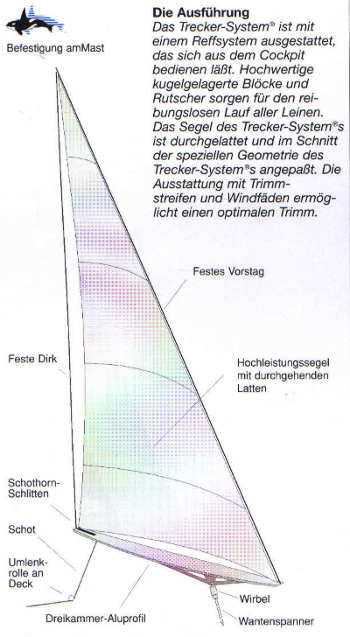
Trecker
The head sail is some special kind of boom jib. The rotation point of the boom is not at the front of the boom but at some distance from the front, just like with a balanced rudder. The advantages of this system are:
- Boom. The jib is always boomed out. No sail flapping during little wind or rolling seas.
- Shape. The jib, which will never be rolled up, is fully battened and has a consistent shape. The bottom leech is tensioned over the boom.
- Reefing. With a roller furling reefing is always a compromise, because with strong wind one needs a highly tensioned forward leech for a flatter sail shape, but with a partialled furled sail the tension goes down the drain and the sail shapes more like a bag. Reefing of the Trecker sail however is much like reefing of the main sail where the whole sail is just lowered a bit as a whole. In the reefed configuration the sail maintains the ideal shape and tension and the sail area is on a lower position than with a roller furling, putting the wind load somewhat lower on the mast.
- Lower center of gravity and lower center of wind force when the sail is down.
- Low aerodynamic disturbance. The leading edge of the sail doesn't experience disturbance of the air coming from its furling system, because there isn't any. Aerodynamics teaches us that the leading edge of an airfoil needs to be "clean": an aerodynamic disturbance in this area propagates over the entire surface and has quite a negative influence on the performance of the whole airfoil. Note that because of the pivot point of the Trecker the leading edge swings away from the furler on the fore stay.
- Self tacking. Tacking goes automatically without any sailor intervention. It works the same like for the main sail: when tacking the sail goes over by itself. There is only one jib sheet, just like with the main sheet.
- Low forces on the jib sheet. Since the boom of the jib is balanced, i.e. extending in front of its rotation point, it works like a balanced rudder and the remaining forces are so low that one can usually adjust the head sail without using any blocks or winches.
- Built in preventers. At the tip of the boom in front of its rotation point there are two lines attached which run all the way to the cockpit. These lines can be used to hold the boom in position to prevent it from unwanted gybing or banging around.
Of course there are a few disadvantages:
- When dropping the sails the jib needs to be folded, so one has to go the foredeck to take care of the sail.
- The reefing system, which enables reefing without having to go to the fore deck, is a somewhat complicated system with many blocks and lines which can of course jam. Especially shaking out the reefs is sensitive for jamming, so sometimes one needs to go to the fore deck just to help a little bit, but of course this is not such a major problem due to the fact that shaking out a reef is usually done when the conditions are calm. And of course roller furlings have their jamming problems too.
Roller furling
Although we are happy with the performance of the boom jib we later decided to add a roller furling on the forestay. The main reason was that with a circumnavigation one sails often downwind and this makes reefing the boom jib a bit unpractical because you have to turn it into the wind. We often got squalls during the night and temporarily reefing would be much easier with the roller furler. We now have the choice between both best solutions and the added redundancy is an additional advantage.
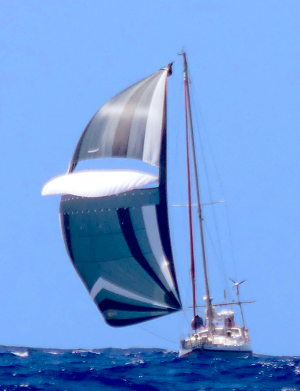
Parasailor
This is a light wind sail like a spinaker. The most obvious feature is the "parachute" halfway up the sail. This parachute brings a few advantages:
- Stability. If the wind momentarily ceases the sail doesn't collapse but the sail stays aloft, floating on its parachute. Usually the Parasailer is still aloft when the wind returns so the result is a sail which is very stable and can handle fluctuating wind very well.
- Spreading. The air filled parachute spreads the sail open in the center. A boom is never required.
- Lift. The wing generates an upward lift which prevents the bow from digging in.
- Safety valve. During a sudden strong gust the air can escape from the gap in the sail. We never tried it ourselves but other sailors claim to have used the sail with gusts up to 30 knots.
Electrical system
Producers
We have put quite some attention to our energy supply, especially the solar installation, because we never wanted to be forced to start the engine only for the purpose to generate electricity, and we want to be as much independant of fossil fuels as possible. So we use an electrical bread baking machine, we make tea with an electric water cooker and we heat food in a microwave. Besides this we have a more than average amount of electrical devices on board. But the more than 500 Watt of solar power can usually supply all the electricity we need.
| Batteries: | 55 Ah engine battery, AGM 400 Ah "house" battery |
| Alternator: | 110 Amp |
| Solar power: | 2 x 255Wp solar panels combined with a 50 Amp MPPT-controller |
| Wind generator: | AIR-X marine, 350 Watt |
| Inverter: | 1200 Watt |
Comsumers
Because of the efficiency we select our electrical devices on their ability to directly use our 12 Volt system as much as possible, with the exception of the high power devices which are fed via an inverter. During the years we collected quite some USB-powered devices like smart watches, mobile phones, e-readers, iPads, etc. and for this trip we also added a USB-rechargable camera, USB-rechargable flash light and even a USB-rechargable hot glue pistol. So we did some shopping on eBay and aquired a bag of USB wall mount connectors which directly convert 12 Volt into the USB 5 Volt. Without load they hardly draw any power and when loaded the efficiency is almost 100%.
The inverter is only used for high power devices, like the electric water cooker, baking machine, microwave, grill, etc. We wanted to limit the power to 1200 Watt, because with 1200 Watt the load on the 12 Volt side is already 100 Amps! So we can only use one high power device at a time and it can not consume more than 1200 Watt. Especially for the electric water cooker it took some efforts to find a suitable model.
Refrigerating
The refrigerator is a notorious power consumer. When our old refrigerator became defective, we replaced it with a new one which doesn't expell its heat into the surrounding air but into the sea water. This saves a lot of unwanted heat and noise generation in the cabin, and the power demand is only half of that of a conventional system, because sea water usually has a lower temperature than the air and can take heat away much more efficiently than air anyway.
Lights
All lights, inside and outside, have been replaced by LED-lights. This was quite a nice saving on electrical power consumption and it is nice that we don't have to be careful with using the lights.
Navigation
Omweg was equipped with an older navigation system combined with a radar. The choice was to replace everything (and throwing away a still functional radar) or to install a new radar less navigation system in addition to the old system with radar. We chosed the latter, but it was difficult to find a suitable system. Flexbibility and costs of the charts was always a deal breaker. Finally we decided upon a laptop based open source system, because of the costs as well as the flexibility.
- Operating system
- We use Navigatrix as operating system. Navigatrix is a Linux based operating system especially designed for sailors and has all interesting software pre installed.
- Navigation program
- We use OpenCPN as our primary navigation program, which also projects the AIS-data on the moving map. OpenCPN is open source and has features which can sometimes not even been found on the most expensive "factory" devices. And you can add charts from any sources you can find; Many countries publish free chart data (which has already been paid for by its tax payers) to enhance the safety of mariners in their waters.
Dell XT2 XFR 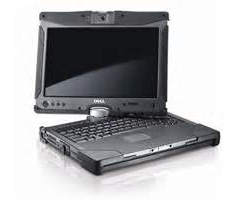 The screen of this outdoor laptop can be turned around so it can be flipped over the keyboard to create a tablet. All connections are water proof. The screen is readable in full sun light.
The screen of this outdoor laptop can be turned around so it can be flipped over the keyboard to create a tablet. All connections are water proof. The screen is readable in full sun light. - Laptop
- We bought a "rugged" laptop on eBay: the Dell XT2 XFR. This "field" laptop has some very interesting features for our purpose:
- The display has been designed to be "outdoor readable". And it works perfectly! Even in full sun light the display can be easily read.
- The display can be turned around so that you can flip it upside down on the keyboard and convert it into a tablet. Of course the screen is a touch screen so you can operate everything with just your fingers. We have mounted this laptop in tablet configuration on the wall of the cockpit.
- The laptop can handle some water (IP54). All connectors are equipped with covers and the screen and keyboard are water proof as well.
- Low power consumption. During navigational use the laptop consumes less than 1 Amp from our 12 Volt system.
- These laptops are "outdated". Once they were very expensive, but now they are available on eBay for 300 USD. "Outdated" means that they might have difficulties playing the most recent computer games, but for our purpose these laptops are sufficiently powerful. We bought a few of these laptops, as spares but also for personal use. Our more powerful laptops stay at home because they are unreadable in sun light, use way too much power, and will probably give up the ghost after a few drops of water. It is interesting how priorities can change.
- Connections
- OpenCPN cooperates with all kinds of NMEA devices, but to keep the laptop "wireless" we use a special NMEA-multiplexer which combines all NMEA sources and puts them as a single data stream on our internal wifi network.
Omweg had no electronic wind indicator, so we bought one. Without display, because the output is NMEA which can be displayed by OpenCPN on the laptop.
Communication
- AIS
- We bought a "black box" without display but only a NMEA output. The AIS has a built in antenna splitter and is connected to our primary VHF antenna in the top of our mast. The range is therefor quite large. Very handy in emergency situations but in pirate areas we use the "stealth button" so we can still see others but remain invisible at the same time.
- VHF / Mariphone
- We have a Standard Horizon GX2000E. This one has all the DSC-features and can display waypoints and AIS data on its tiny display, so we can use that as a backup for our navigation laptop.
- SSB
- For long range short wave communication we use an Icom 706. A compact powerful unit equipped with loads of features. We can use it legally because I had already aquired a short wave HAM license long time ago. Except for long range communication with other cruisers and the coast guard the shortwave is also handy to receive weather faxes and grib-files. For the latter we use a Pactor modem, which is also connected to our wifi system.
- Satellite
- After extensive research we came to the conclusion that satellite communication is not (yet) for us. We have an Iridium satphone for emergencies only but we are not really satisfied with the providers, the service and the phone itself.
- Wifi
- Our Wifi system consists of two parts: an internal access point ("SY-Omweg") to which our laptops, smart phones, etc. are connected. Whe never have to connect all these individual devices to a local wifi station but just keep them connected to our own private wifi system. This wifi system provides the following sources:
- The NMEA-multiplexer which supplies all NMEA data to the wifi system.
- The Pactor-modem.
- An external wifi client-bridge (Ubiquiti Bullet M2-HP). This is a powerful wifi transceiver connected to a home built directional antenna on our device carrier. We can use this to connect to the wifi of the marina or whatever we can find as a suitable source, possibly kilometers away. And this is then fed into our own private wifi system.
- Low speed Iridium-satelliet connection. We planned to do this but at the moment we still haven't setup a satellite system.
Full specifications
Hull
Design
- Reinke Super 11.
- Aluminium. 8mm bottom, 6mm below waterline, 5mm above the waterline.
- Twin-keel with asymmetric profiles. Low draft, can be beached.
Dimensions
- Length: Originally 11.67 meter. Excluding swimming platform.
- Beam: 3.48 meter
- Draft: 1.35 meter
- Mastheight: 14 meter
- Tonnage: 9.5 ton
- Dieseltank: 400 liter
- Watertank: 400 liter
Steering
- Tiller steering
- Wind pilot “Pacific”, overhauled in 2016.
- Electric tiller pilot, modified in 2016 with external super duty linear actuator.
- Electric Simrad TP-32 tiller pilot, new 2015.
Anchor
- Rocna anchor 25Kg. New 2015.
- 50 meter 8mm DUPLEX 1.4462 DIN 766 anchor chain. New 2015. Doesn't rust even in tropical waters!
- 2 additional anchors.
- Anchor wash system.
- Lofrans elektrical anchor winch. Overhauled in 2015.
Illumination
- LED navigation lights
- LED tri-color light
- Stoomlicht
- LED deck light
- LED cockpit light
- LED sail light
- LED swimming platform / boarding ladder light.
Interior
- Decksalon concept. View outside while seated. Large storage space under salon deck.
- High quality wood work, many details.
- Arctic insulation.
- Double pane windows, mirror glas for privacy. Halfway covers on the front windows.
- Oil cabin heater. We never need it, never tried. "As is".
- Seven hatches, all with covers and musquito nets.
- Lavac vacuum toilet.
- LED illumination and fluorescent illumination, all warm white.
- Force 10 stove with remote controlled propane valve directly on the tank.
- Afzuigkap.
- Microwave.
- Elektric water boiler, 1 liter.
- Faucets with foot pumps. Low maintenance, low risc on leakage, no power consumption. Seawater and freshwater in the galley, fresh water in the head.
- 50 Liter Isotherm refridgerator with water cooling. Extremely efficient.
- Jensen sound system with bluetooth and USB.
- 3 hella 12V fans.
- 4 double USB power outlets.
- 7 12 Volt power outlets.
- 3 220 Volt power outlest.
Sails
- New rigging 2015/2016.
- Parasailor, 105 M2, 2015.
- Trecker self tacking fully battened boom jib. 1 reef position. New 2015
- Profurl roller furler, new 2016
- 40 M2 jib. new 2016
- Main sail, 2 reef positions. new 2015
- Swedish sail.
Engine and propulsion
- Engine: Vetus M4.55 (turbodiesel 52pk), replaced in 2015, 900 hours.
- Transmission: Hydraulic gear (replaced in 2015, 900 hours), Python-drive (new 2015), prop shaft brake (new 2015).
- Prop: 3-blade Autoprop with automatic variable pitch, new 2015
Energy
- 440 Ah AGM batteries, new 2015.
- 60 Ah engine battery, new 2015.
- 110 Amp alternator.
- Air-x 350 wind generator. Silent blades, replaced in 2015.
- 2 255Ah solarpanels on sliding frame. 255 Ah collapsed, 510 Ah extended. New 2015.
- Victron energy smart MPPT controller. 2015
- Victron energy BMV-702 battery monitor. 2015
- 30 Amp grid charger, 240 Volt. 2015
- Automatic charging relay with switch on panel.
- 35 circuit breakers in elektric panel.
- 4 double USB power outlets.
- 1200 Watt 220 Volt inverter.
- 7 12 Volt power outlets.
- 3 220 Volt power outlets.
Navigation and communication
- Systeem based on NMEA over WIFI. WIFI system carries GPS, AIS, Windmeter, DSC, Pactor 4 modem data.
- Wifi Access Point with network drive. For connection with NMEA, Pactor and Internet.
- Long range external Wifi receiver to connect the internal wifi to the outside world.
- Outdoor tablet/laptop with touch screen, runs Navigatrix. Main navigation software is OpenCPN. It is possible to run multiple OpenCPN sessions at the same time on Laptops and Android smart phones/tablets. Also contains the SSB email server.
- Radar.
- Tridata depth sounder/log/seawater temp.
- Standard Horizon AIS VHF GX2000 with external RAM-3 control microphone in the cockpit. 2014.
- Weatherdock AIS transmitter/receiver with built-in antenna splitter. 2014.
- Icom 706 SSB
- Icom AT130 antenna tuner. 2015
- HF-150 Shortwave receiver.
- Standard Horizon HX870 handheld VHF with DSC and GPS. 2015
- Ocean signal EPIRB, 2015. Battery ok until Sep 2020.
Safety
- 3 automatic elektric bilge pumps with alarm
- 2 manual bilge pumps
- Seasafe 6 person life raft, new 2014, never used.
- Ocean signal EPIRB, 2015. Battery ok until Sep 2020.
- Jordan series drogue, with mounting points on the hull. 2015, never used.
- Assortiment pyro stuff, leak stoppers, etc.
Miscellaneous
- Dinghy, Walker Bay, Hypalon, hard bottom, new 2016.
- Spare parts, tool, too much to specify.
- Full galley equipment, too much to specify.
To buy separately
- Watermaker Katadyn Powersurvivor 40E, overhauled 2016.
- Nissan/Tohatsu 9.8 HP 2-stroke outboard, new 2016.
- 2 12L aluminium scuba dive tanks.
- Iridium sat phone.
- Pactor 4 modem with optional ethernet module. 2014
